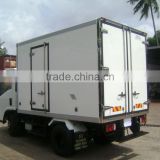Multifunctional freezer container for truck made in China
USD $50 - $100 /Piece
Min.Order:1 Piece
Quick Details View All >
Zhucheng Joyfly Imp&Exp Company Limited
Product Details
the fix is simple for cab bolt or cab rain gutter.
Truck Fairings and Trailer Skirts - Diesel Misers
Foam guiding cover
platform individually
mode experment
rotating fairing;
rotatingfairing
Plastic Fairings Could Cut Truck Fuel Use
streamlined dome
fairwater cone
bossing
air guide sleeve
air deflector
Plastic Fairings Could Cut Truck Fuel Use
TOTAL VEHICLE AERODYNAMICS
Airodyne continues to advance Fuel Savings with EPA Smartway Certified Trailer Technologies,
that are CARB compliant for 2010 legislation requiring trailer aerodynamic devices when operating in California.
AeroCurtains - Awarded EPA's Highest Rating (Advanced) for Fuel Savings Over 6%
Committed to Providing Quality, Performance-based products designed for real-world applications.
Cab Roof Fairings (simple delflectors or fully-enclosed fairings) - from $50-100 for deflectors (CALL FOR FLEET PRICING) - Reduce Fuel Consumption by 1 Gallon/Hour (compared to idling)
The Energy Department is touting a technology that would save 1.5 billion gallons of fuel a year
if it were affixed to every long-haul truck in America.
That's no mean feat, but according to those developing the technology,
it should have wide appeal in a tight-fisted trucking sector that's been slow to get more fuel-efficient.
DOE said the UnderTray System, a set of plastic fairings that fit in front of the wheels under
the trailer of a big rig, cuts a truck's fuel use 7 to 12 percent.
That means it would pay for itself in six to 18 months, according to Mitch Greenberg,
president of SmartTruck. It's one of the two small companies from Greenville, S.C.,
that worked with DOE to develop the UnderTray.
This payback period hits the "sweet spot" for long-haul truckers, whose main cost is fuel, but who also face an ultra-competitive market. Many truckers hesitate to make upfront efficiency investments
they may not be around to reap. Paybacks beyond one and a half years are thought to be
uneconomical.
SmartTruck and BMI Corp., of South Carolina, thought the UnderTray would interest
that market. When an 18-wheeler roars down the highway, a low-pressure pocket of air forms behind it. This pocket sucks the truck backward,
forcing it to consume ever more fuel just to keep its speed.
Simple answer to a 'very complex' problem
The UnderTray punctures that pocket by channeling the rushing air from beside the truck so
it goes underneath it and out the back.
This raises the air pressure behind the truck and reduces the efficiency-sapping drag.
The companies used a supercomputer at Oak Ridge National Laboratory to improve their design.
ORNL, a DOE lab, has Jaguar, the second-largest computer in the world, about 100,000 times as powerful as an everyday laptop.
"The airflow around a vehicle is very, very complex," said Greenberg of SmartTruck. "
To do mathematical modeling to try and, number one, understand that complex airflow,
understand where the pressure is changing, understand where all the drag is actually coming from,
you need incredible computer power to solve all of those mathematical iterations."
DOE said the companies went from concept to market-ready design in a year a half; without the supercomputer, they had expected it to take three and a half years.
Greenberg said the companies will target long-haul fleets whose trucks clock about 100,000 miles a year. He said payback could be closer
to six months for the many one-man businesses in the trucking industry.
Payback may not influence everybody
Can they attach UnderTray to every long-haul truck in America? Don Anair, senior analyst for the Union of Concerned Scientists,
said most fleets will take a look.
"However, even with these payback levels, adoption of new technology in this market is slow,"
he said. "For trailer technologies -- there are additional problems."
For one thing, the trucks and trailers are often owned by different people, so the benefit gets
diffused between them. Also, fleets often keep more trailers than trucks, so a more fuel-efficient trailer may sit at the depot most of the time, which extends the payback period.
U.S. EPA and the Department of Transportation are working on the first-ever fuel-efficiency standards for trucks. By the 2018 model year, the new trucks will have to use 20
percent less fuel, and cause 20 percent fewer greenhouse gases, than today's models
Anair said UnderTray won't count for these standards because it's on the trailer,
not the "tractor" where the driver sits. But he said the agencies intend to set standards for trailers,
as well. California already has. UnderTray exceeds the state's requirement of 5 percent fuel improvement.
The DOE announcement comes as research and development budgets face the knife in Congress.
Next week, White House officials are expected to call for doubling the budgets of agencies that do
basic research. These budgets eventually flow to labs such as ORNL.
nudking packing or wood box
customer supp cab infomation ,we can drawing it too.
Contact Supplier

You May Like


New Products
Popular Searches
Recommended Products
Find Similar Products By Category